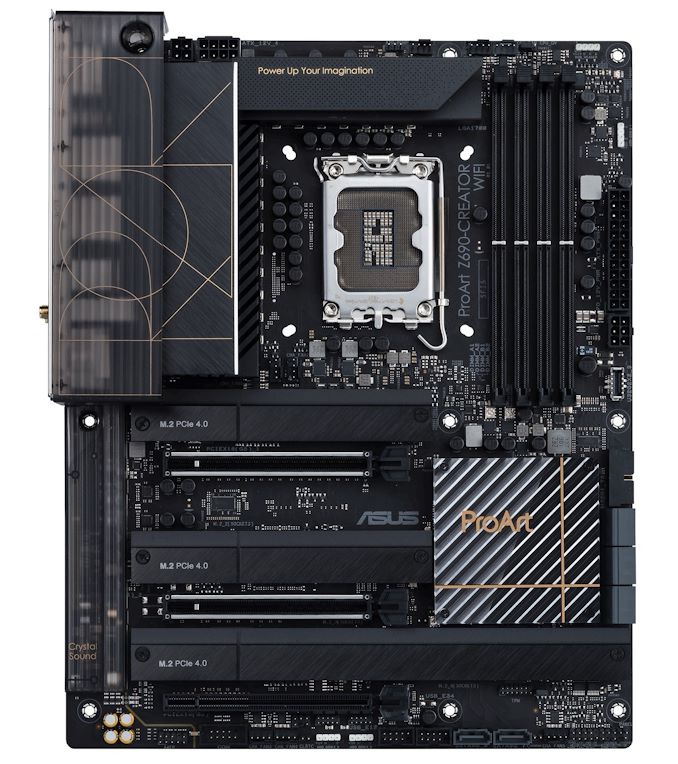The Intel Z690 Motherboard Overview (DDR5): Over 50+ New Models
by Gavin Bonshor on November 9, 2021 9:00 AM ESTASUS ProArt Z690 Creator WIFI (DDR5)
Designed primarily for content creators, but more than adequately adapt for the foundation to any type of desktop system a user may wish to create, ASUS has its ProArt series. Some of the ProArt series main features include Thunderbolt connectivity for super-fast transfer speeds and typically features a more reserved and elegant aesthetic. The ASUS ProArt Z690 Creator WIFI ticks all of these boxes, with a primarily black theme with elements of goldish colored and white contrasting lines on the heatsinks. ASUS opts to neglect RGB LED lighting here and goes for a more subtle styling throughout.
Dominating the lower section of the ATX-sized PCB is a trio of full-length PCIe slots. The top two full-length slots both support PCIe 5.0, with the slots operating at either x16 or x8/x8, with the third full-length slot along the bottom electronically locked down to PCIe 3.0 x4. For storage, ASUS includes a total of four M.2 slots, with three offering support for PCIe 4.0 x4 M.2 drives, and the fourth slot capable of supporting both PCIe 4.0 x4 and SATA varieties. There are also eight SATA ports with all of these allowing for RAID 0, 1, 5, and 10 arrays to be built. Memory support is provided by four memory slots, with speeds of up to DDR5-6000 supported, with a combined capacity of up to 128 GB.
On the rear panel of the ASUS ProArt Z690 Creator WIFI are two Thunderbolt 4 Type-C ports and a total of six USB 3.2 G2 Type-A ports. There's also a pair of DisplayPort video inputs for Thunderbolt 4, as well as a single HDMI 2.1 video output for users looking to use integrated graphics. The board's onboard audio capabilities consist of five 3.5 mm audio jacks and S/PDIF optical output powered by a SupremeFX S1220A HD audio codec, while ASUS also includes a Marvel AQtion 10 GbE and Intel I225-V 2.5 GbE controller pairing for wired networking. Wireless capability comes from a Wi-Fi 6E CNVi, with additional support for BT 5.2 devices. Finishing off the rear panel is a small BIOS Flashback button.












126 Comments
View All Comments
GeoffreyA - Saturday, November 13, 2021 - link
Certainly, there are tradeoffs, keeping a socket; but, as Mr. Tuvok would say, "Ryzen, you are an unending source of astonishment." There was a time when sockets even took CPUs from different manufacturers. I remember my Socket 7 motherboard, though I never tried it, could take a K5 and some Cyrix CPUs as well. Those 5x something, something. How things have changed.A short-lived socket can be a pain in the behind too. I was one of those unlucky folk who ended up with Socket 754 and missed out on dual-channel DDR and a long upgrade path. In any case, that computer went kaput after four years.
Oxford Guy - Wednesday, November 10, 2021 - link
Overclocking is for employees of motherboard companies.ECC RAM support should have been a standard feature from the beginning. Apple offered it on the Lisa in ‘83 and consumer computing has gone backward since.
Doublers, though... aren’t a bad thing as long as they’re implemented well — as I understand it. Better to have a good doubler implementation than a weak individual phase system. The main thing is to have a board meet the minimum spec for reliable (i.e. not overheating and/or failing) long-term support of its supported CPUs. Anything beyond that is unnecessary.
GeoffreyA - Saturday, November 13, 2021 - link
The problem with doublers is, they over-use it as a marketing technique to give the impression that a certain board has a large amount of phases.Oxford Guy - Saturday, November 13, 2021 - link
Weak phases with a mediocre/poor regulator aren’t necessarily better than ‘marketing phases’ via the use of doublers. That’s the case when the doublers are used a correctly.There are a lot of shenanigans, though — like not even utilizing the doubler fully but counting it as the doubling of phases. I also recall that one of the big tricks was putting extra chokes on the board to make it look like there are more phases.
GeoffreyA - Sunday, November 14, 2021 - link
Quite right, and one of the reasons why people have got to read a proper analysis of the VRM, or take a look at the lists on hardwareluxx for example.t.s - Tuesday, November 9, 2021 - link
Wish Intel go with their atv12vo. Or like business lines from HP, Dell, Lenovo, etc. 6 or 8 pin.shabby - Tuesday, November 9, 2021 - link
Mobo prices will go up even more, screw that.meacupla - Tuesday, November 9, 2021 - link
In the long term, I think the cost for ATX12VO will be cheaper.ATX12VO PSU will be cheaper than a comparable quality ATX PSU.
The BoM for 12V to 5V and 12V to 3.3V converters would go down, if mobo makers decide to stick to a single, standardized design.
With the way things are looking, electricity prices are unlikely to go down and continue to go up.
DigitalFreak - Tuesday, November 9, 2021 - link
All ATX12VO is doing is shifting the cost from the PSU to the motherboard.Wrs - Wednesday, November 10, 2021 - link
If mobo makers can stick to one design why can't PSU makers? They already conform to ATX.ATX 12 VO increases costs for piecemeal upgraders because of the simple observation that PSUs outlive motherboards. The question would be whether the power savings are worth it. For prebuilts they're comparing power savings to 0 net component cost so 12VO is already the norm.